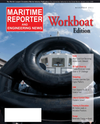
Page 55: of Maritime Reporter Magazine (November 2011)
Feature: Workboat Annual
Read this page in Pdf, Flash or Html5 edition of November 2011 Maritime Reporter Magazine
NOFI were able to exceed both goals, with Elastec/Ameri- can creating a system that exhibited a staggering Oil Re- covery Rate (ORR) of 4,670 gpm, with an efficient of 89.5% oil to water recovered; and NOFI exhibiting an average ORR of 2712 gpm with an average ORE of 83% THE WINNERSElastec/American Marine, a manufacturer of oil spill and environmental equipment known for innovation in machin- ery design, is a self-funded, privately held Midwest corpo- ration that has grown to become one of the largest manufacturers of oil spill equipment in North America. The company, which started over 20 years ago, has grown into a 100+ workforce that has gained a global reputation for its technological innovations. In the X-Prize competition, Elastec/American Marine reached more than three times theindustry?s previous best oil recovery rate tested in controlled conditions.Team leader Don Johnson is manager of the Elastec/American Marine Aluminum Boat Division, and has 30 years experience in the design and manufacture of recre- ation vessels. He was embedded at the Deep Water Horizon event as an onshore facilitator representing Elastec/Ameri- can Marine for the In-Situ burn task force. To know the Elastec/American Marine Team story, it is essential to start from the beginning of the company. Elastec/American was started by Donnie Wilson and Jeff Cantrell, started as any other Southern Illinois oilfield serv- ice company. From the start it was their innovation that earned them a solid reputation, as oilmen with a problemwith machinery design would come to see them. ?They would draw out a design on a napkin and say 'Can you build this?'" Wilson said. ?We're still doing that - solving prob- lems.? Elastec/American holds two international patents and six domestic patents on its products, and it got its start in thebusiness of oil recovery systems after responding to a small, local oil spill. The equipment being used wasn't doing the job very well, and Wilson said he asked Cantrell to throw him a five-gallon plastic bucket to help in the recovery. Luckily Jeff?s aim was off that day, and the wind caught the bucket and blew it into the spill on the water. The wind con- tinued to turn the bucket and Wilson noticed that as the bucket turned, oil stuck to the side of it, leading them to their first invention of oil recovery equipment. So it began. That bucket spawned the company?s barrel skimmer. Never satisfied with the ?norm? Wilson and Cantrell con- tinued their pursuit to design and deliver an even more effi- cient skimmer apparatus, and in 1990 it obtained the first of many patents for innovation in the field of pollution control equipment. Fast forward to April 20, 2010: the Transocean drilling rig, Deepwater Horizon, exploded. This event was immediately devastating as 11 crewmen were killed. The rig sank two days later. As information was being gathered, it was not known how much, if any, oil was being leaked into the Gulf of Mexico. By Saturday, April 24th an oil leak was reported near the sunken rig. Over the course of the coming months it became the largest oil spill in U.S. history. Elastec/American Marine was contacted on the morning of April 26, with a request for Hydro-Fire Boom, a request that led to Wilson and Cantrell personally driving a truck loaded with equipment toward New Orleans. While all the resources and options were being gathered and assessed for managing the response, the U.S. Coast Guard announced itwould conduct a test using fire resistant boom to burn the oil November 2011www.marinelink.com 55MR Nov.11 # 7 (50-56):MR Template 11/3/2011 9:07 AM Page 55

 54
54

 56
56
